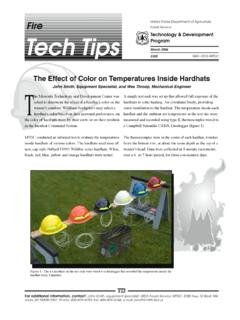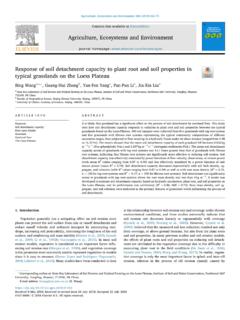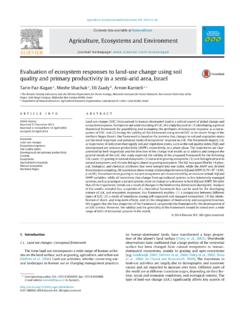Transcription of Agriculture, Ecosystems and Environment
1 agriculture , Ecosystems and Environment 188 (2014) 1 11 Contents lists available at ScienceDirectAgriculture, Ecosystems and Environmentj ourna l h om epage: and carbon dynamics in prairie vegetation strips acrosstopographical gradients in mixed Central Iowa agroecosystemsMarl n P rez-Su reza,b, Michael J. Castellanoc, Randall Kolkad, Heidi Asbjornsene, ,Matthew HelmersfaDepartment of Natural Resource Ecology and Management, Iowa State University, 339 Science II, Ames, IA 50011, USAbInstituto de Ciencias Agropecuarias y Rurales (ICAR), Universidad Aut noma del Estado de M xico, Carretera Toluca - Atlacomulco Km.
2 ,CP 50000 Toluca, MexicocDepartment of Agronomy, Iowa State University, Ames, IA 50011, USAdUSDA Forest Service, Northern Research Station, 1831 Hwy 169 East, Grand Rapids, MN 06514, USAeDepartment of Natural Resources and the Environment , University of New Hampshire, Durham, NH, USAfDepartment of Agricultural and Biosystems Engineering, Iowa State University, Ames, IA 50011, USAa r t i c l e i n f oArticle history:Received 14 September 2013 Received in revised form 23 January 2014 Accepted 28 January 2014 Keywords:AgricultureC3:C4ratioCarbonN cyclingPlant litterPlant N uptakea b s t r a c tReductions of nitrogen (N) export from agricultural lands because of changes in specific N stocks andfluxes by incorporation of small amounts of prairie vegetation strips (PVS) are poorly understood.
3 Theprimary objective of this study was to evaluate the effect of the presence and topographical position of PVSon soil and plant carbon (C) and N stocks relative to annual crop and native prairie vegetation. The studywas implemented within three small adjacent watersheds, treated with one of the following cover types:(1) 100% row-crop agriculture (CROP); (2) 20% prairie vegetation (PVS) distributed along the contouracross three topographical positions: upslope, sideslope and footslope position; and (3) 100% 17-year oldreconstructed native prairie (RNP) as the control condition.
4 Total soil organic C (SOC), total soil N (TN),inorganic N availability as indexed by ion exchange resins, N stocks in plant biomass and litter, and theratio of C3:C4plant species were measured during the 2010 growing season. Results showed that over fiveyears of treatment, PVS footslope improved soil quality by increasing TN by almost 100% and SOC by 37%;while CROP footslope TN decreased by 31% and SOC decreased by 28%. Overall, N stocks in plant biomassand litter were higher in PVS compared with RNP, except in the footslope where the lower N plant stockswas associated with higher C3abundance in RNP.
5 Nitrogen availability was higher in CROP ( ),followed by PVS ( ), and RNP ( ); with the highest values recorded in the upslope positionfor PVS and RNP, and the footslope for CROP. These findings are important for designing watersheds withPVS to reduce N accumulation in the footslope position and promote additional N retention in soil organicmatter and plant biomass, thereby minimizing N losses to streams. 2014 Elsevier All rights IntroductionIn the Midwestern , conversion of native tallgrass prairieto intensively managed row-crop agriculture with high inorganicnitrogen (N) fertilizer inputs has significantly altered the N cycle(Lauenroth et al.)
6 , 1999; Robertson and Vitousek, 2009). One of themajor consequences of this land use change is increased N export togroundwater, streams, and rivers (Robertson and Vitousek, 2009).These N losses contribute to reduced soil fertility (Lauenroth et al.,1999) and expansion of the seasonal hypoxic zone in the Gulf of Corresponding addresses: Asbjornsen).Mexico (Alexander et al., 2008; Goolsby et al., 2001; Howarth et al.,2000).Strategies to reduce N export from agricultural lands haveincluded the establishment of riparian buffer systems (Dosskeyet al.
7 , 2002; Lovell and Sullivan, 2006) and, more recently, theincorporation of small amounts of prairie vegetation strips (PVS)in strategic locations within crop fields (Asbjornsen et al., 2013;Helmers and Eisenhauer, 2006). Both riparian buffers and PVSfunction as physical barriers that reduce N losses by minimizingsoil erosion (Dosskey, 2001; Dosskey et al., 2002; Helmers andEisenhauer, 2006; Hern ndez-Santana et al., 2013; Zhou et al., 2010,2014). Additionally, riparian buffers and PVS retain NO3-N throughbiogeochemical transformations resulting from plant uptake andmicrobial processes.
8 These transformations include NO3-N trans-fer to above and belowground plant tissues, denitrification,0167-8809/$ see front matter 2014 Elsevier All rights M. P rez-Su rez et al. / agriculture , Ecosystems and Environment 188 (2014) 1 11immobilization by microorganisms, leaching (Barrett and Burke,2000; Kaye et al., 2002).In native tallgrass prairie Ecosystems , plant species compositionis an important factor that can influence N and C cycling and storage,particularly due to species-specific traits associated with the C3andC4plant functional groups that typically dominate these ecosys-tems (Eviner et al.)
9 , 2006; Hobbie, 1992; Wedin and Tilman, 1990).For example, C4prairie grasses typically produce more biomass(both above- and below-ground) and have more recalcitrant tissue( higher C:N and lignin:N ratios) than C3grasses and forbs (Baeret al., 2002; Wedin and Tilman, 1990). Consequently, increasingdominance of C4species generally decreases N and C mineraliza-tion rates (Baer et al., 2002; Epstein et al., 1998; Mahaney et al.,2008). In contrast, C3forbs have deeper roots and take up morewater and nutrients (Nippert and Knapp, 2007) and accumulate Nand C deeper in the soil layers compared to C4grasses (Fornara andTilman, 2008).
10 Therefore, simultaneous presence of different plantfunctional groups with different functional traits may sustain mul-tiple ecosystem services in grassland Ecosystems as result of nichepartitioning that allow the species to capture resources in ways thatare complementary in space and time (Fornara et al., 2009; Fornaraand Tilman, 2008; Nippert and Knapp, 2007). Therefore, incorpo-ration of a C3and C4species mix within crop fields should increaseplant functional complementarity in PVS promoting retention of Nfrom agricultural watersheds.



















